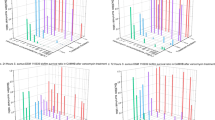Abstract
Biofilm-related infections have become a major clinical concern. Typically, animal models that involve inoculation with planktonic bacteria have been used to create positive infection signals and examine antimicrobial strategies for eradicating or preventing biofilm-related infection. However, it is estimated that 99.9% of bacteria in nature dwell in established biofilms. As such, open wounds have significant potential to become contaminated with bacteria that reside in a well-established biofilm. In this study, a modified CDC biofilm reactor was developed to repeatably grow mature biofilms of Staphylococcus aureus on the surface of polyetheretherketone (PEEK) membranes for inoculation in a future animal model of orthopaedic implant biofilm-related infection. Results indicated that uniform, mature biofilms repeatably grew on the surface of the PEEK membranes.



Similar content being viewed by others
References
Bakken LR (1985) Separation and purification of bacteria from soil. Appl Environ Microbiol 49:1482–1487
Buckingham-Meyer K, Goeres DM, Hamilton MA (2007) Comparative evaluation of biofilm disinfectant efficacy tests. J Microbiol Methods 70:236–244
Campoccia D, Montanaro L, Arciola CR (2006) The significance of infection related to orthopedic devices and issues of antibiotic resistance. Biomaterials 27:2331–2339
Chou TG, Petti CA, Szakacs J et al (2010) Evaluating antimicrobials and implant materials for infection prevention around transcutaneous osseointegrated implants in a rabbit model. J Biomed Mater Res A 92:942–952
Costerton JW (2005) Biofilm theory can guide the treatment of device-related orthopaedic infections. Clin Orthop Relat Res 437:7–11
Costerton JW, Geesey GG, Cheng KJ (1978) How bacteria stick. Sci Am 238:86–95
Darouiche RO, Mansouri MD, Zakarevicz D et al (2007) In vivo efficacy of antimicrobial-coated devices. J Bone Joint Surg Am 89:792–797
Darouiche RO, Mansouri MD, Gawande PV et al (2009) Antimicrobial and antibiofilm efficacy of triclosan and Dispersin B combination. J Antimicrob Chemother 64:88–93
Goeres DM, Loetterle L, Hamilton MA et al (2005) Statistical assessment of a laboratory method for growing biofilms. Microbiology 151:757–762
Jiang X, Pace JL (2006) Microbial biofilms. In: Pace JL, Rupp ME, Finch RG (eds) Biofilms infection and antimicrobial therapy. Taylor and Francis Group, Boca Raton, p 4
Wimpenny J, Manz W, Szewzyk U (2000) Heterogeneity in biofilms. FEMS Microbiol Rev 24:661–671
Murphy TF, Kirkham C (2002) Biofilm formation by nontypeable Haemophilus influenzae: strain variability, outer membrane antigen expression and role of pili. BMC Microbiol 2:7
Murray CK (2008) Epidemiology of infections associated with combat-related injuries in Iraq and Afghanistan. J Trauma 64:S232–S238
Owens BD, Kragh JF Jr, Macaitis J et al (2007) Characterization of extremity wounds in operation Iraqi freedom and operation enduring freedom. J Orthop Trauma 21:254–257
Rode TM, Langsrud S, Holck A et al (2007) Different patterns of biofilm formation in Staphylococcus aureus under food-related stress conditions. Int J Food Microbiol 116:372–383
Taubes G (2008) The bacteria fight back. Science 321:356–361
Williams D, Bloebaum R, Petti CA (2008) Characterization of Staphylococcus aureus strains in a rabbit model of osseointegrated pin infections. J Biomed Mater Res A 85:366–370
Acknowledgments
This material is based upon study supported by the Office of Research and Development, Rehabilitation R&D Service, Department of Veterans Affairs, Salt Lake City, UT. The project described was also supported by Award Number R01AR057185 from the National Institute Of Arthritis And Musculoskeletal And Skin Diseases. The content is solely the responsibility of the authors and does not necessarily represent the official views of the National Institute Of Arthritis And Musculoskeletal And Skin Diseases or the National Institutes of Health. This study was also supported by the Albert and Margaret Hofmann Chair and the Department of Orthopaedics, University of Utah School of Medicine, Salt Lake City, UT. The authors also acknowledge the help of Brad Isaacson, PhD for his contributions to the design of the modified CDC biofilm reactor and Dennis Romney for machining the modified reactor parts.
Author information
Authors and Affiliations
Corresponding author
Rights and permissions
About this article
Cite this article
Williams, D.L., Woodbury, K.L., Haymond, B.S. et al. A Modified CDC Biofilm Reactor to Produce Mature Biofilms on the Surface of PEEK Membranes for an In Vivo Animal Model Application. Curr Microbiol 62, 1657–1663 (2011). https://doi.org/10.1007/s00284-011-9908-2
Received:
Accepted:
Published:
Issue Date:
DOI: https://doi.org/10.1007/s00284-011-9908-2




